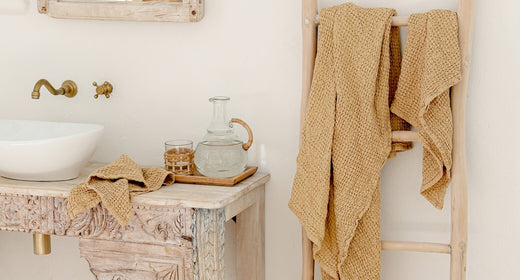Linen care guide
Let’s just start by saying that caring for linen items is simple and rather straightforward — high-quality linen fabric is sturdy and durable on its own so you won’t have to slave away tending to its whims. However, if you want to make the most of your linen items, here are some basic rules you should follow.
How to wash linen
Linen items can be both hand-washed and machine-washed - either of these methods is fine and won’t stretch or shrink your linens. If you do experience damage during wash, it may be related to the quality of the fabric or chemicals involved.
Machine wash:
1. Separate white, dark, and colored linens. For best results, turn linens inside out and wash them separately from other fabrics. It’s important to avoid mixing heavy items like jeans, hoodies, or towels in a load with linen textiles.
2. Wash in lukewarm water (<40°C/104°F). High temperatures may cause shrinkage of up to 10% and weaken the linen fiber.
3. Use the gentle machine cycle and don’t overload your washing machine.
4. Use mild detergent formulated for delicate fabrics. Avoid detergents that contain substances like Sodium Borate, Sodium Hydroxide, Cellulase, Protease, and Amylase. Don't bleach.




Hand wash:
1. Fill a small container (bucket or sink) with lukewarm water and add about a teaspoon of mild detergent.
2. Submerge the linen garment in lukewarm water and let it soak for about 10 minutes.
3. Gently swish the item around. Don’t wring, twist or scrub as it can stretch the fabric.
4. Drain the soapy water and rinse repeatedly until the soapy residue is all gone. Hang to dry.




How to wash linen bedding?
A lot of you ask us for tips on how to wash linen sheets and other bedding items. The same rules apply with a couple more important things to note. First, prep the laundry by turning them inside out and buttoning up all the buttons, zipping up zippers, tying up ties, etc. Then, make sure your laundry has enough space so it could rinse properly. You can wash linen bedding with other delicates, but do not mix it with heavy items like towels, denim.
How to wash linen clothing?
Because linen clothing is usually more detailed and structured than, for example, linen sheets or duvet covers, it may require some extra attention when washing. One thing lots of people want to avoid - or at least control - is the creasing that happens to linen clothes. A couple of ways to do that is by washing linen clothing in plenty of space and hanging it to dry immediately after the wash.

Related questions
Removing stains from linen
The main rule of getting stains out of linen is doing it as soon as they develop. If you let dirt, oil, grease, and other stains sit, they will absorb deep into the fiber making removal a difficult and annoying task.
If you have a minor spot, try soaking it in a water-detergent solution or washing it with club soda. If that doesn’t help, you can put some dish soap and gently massage it until the dirt comes out, then wash it as you usually would. Some stains are trickier and might come off by sprinkling baking soda and a few drops of vinegar on the fabric, then blotting it with a paper towel to soak up the moisture.
Drying linen
Drying your linens is a method of your own choice, but let us run through the basics. Pre-washed linen items can be easily machine (tumble) dried on low heat or no heat. It is very important not to dry your linens on high heat as it may cause significant shrinkage, especially for clothing.
Remove from the dryer when they’re still slightly damp and hang or lie flat to finish the process. Air drying is another great option (and a must option for clothing) that saves on electricity and adds softness to linen items. Shake out your linens before hanging them or line-drying and once they are mid-dry, lay them flat on a white towel. This helps to avoid the stiffness of linen fabric.
Bleaching linen
Not the best idea. Bleach and detergents with optical brighteners tend to weaken the fibers and may cause discoloration. If you’re dealing with a stain, please refer to the steps mentioned above.
Softening linen
Linen naturally gets softer with every wash, and stone-washed linen should already be at its maximum softness. Fabric softeners (liquid or dryer sheets) weaken the fibers and coat them reducing their absorbency and moisture-wicking properties.
Ironing linen
Natural fibers like linen will wrinkle, crumple, and crease, you just have to accept it. However, if you really want an item pressed, use a medium-hot iron on the fabric while it’s still damp or overlay it with a damp towel.
Storing linen
Make sure your linens are completely dry to avoid mildew. Natural fibers like linen need to breathe, so it’s best to store them in cool, dry, well-ventilated areas and away from direct sunlight. Avoid storing linen in plastic bags — choose linen bags or reuse old pillowcases for that. When it comes to bed linens, we recommend using three sets in rotation: one on the bed, one in the closet, and one in the wash. This will allow each set to rest from wash to wash and prolong the lifespan of your linens.
Love and take care of your linens and we’re sure - they’ll last you for ages!
 United States
United States














